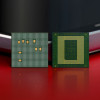Review: LG Voyager
The iPhone's touch screen was a revolution. So simple and easy to interact with that anyone can figure it out in about 60 seconds. I spent two weeks with the Voyager and by the time I packed it up and sent it back to Verizon I had yet to figure out how to get a consistent response from it.
To use the Voyager, you have to unlock it. Tapping the screen does not wake it up. You can either toggle the unlock key on the side of the Voyager or hit one of the hard keys at the bottom of the phone. Using the toggle key opens up the phone almost immediately and you have to take no further action. If you hit the hard keys, the screen will wake up and give you a picture of a lock. It tells you to touch the lock icon if you want to unlock the phone. Doing so produces a quick vibration to let you know you've touched the screen (haptics) and it then unlocks the phone.
Using the screen to choose most menu items and options is fairly straightforward. Touch the right spot on the screen and you get a response and the phone does what you ask of it. Simply tapping an icon works just fine. It's when you want to zoom around the screen or scroll that you find yourself running into issues.
Scrolling through things such as your recent call log or contact database was absolutely maddening. Because the screen doesn't recognize the difference in pressure, you have to be forceful with it to get a reaction. There is no simple, lightweight feather touching. It won't work. The phone may not recognize that you've touched it until after you've already moved your finger or thumb. The number of times I accidentally opened a contact or call log when I intended to scroll down the screen because the phone registered my touch at a different time than I intended it to was too many to count.
I got the best results when I slammed my finger down deliberately (and waited for the haptic vibration), and then scrolled with it and let go sharply. This was more consistent and led to fewer accidental selections.
Using it to scroll up and down web pages was slightly easier. You could be somewhat more delicate with it. But it still felt like you were interacting with a dumber screen than the one used on the iPhone because it couldn't differentiate between the force of your touch and respond accordingly. You have to be blunt with it.
And because it mixes touch on the exterior screen with standard D-pad control on the interior screen, the experience of using the Voyager is a little schizophrenic.


 Verizon Holiday Phones
Verizon Holiday Phones
 Hands On with the moto g power (2022)
Hands On with the moto g power (2022)
 Snapdragon 8 Gen 1 is Qualcomm's New Flagship Chip
Snapdragon 8 Gen 1 is Qualcomm's New Flagship Chip
 Hands On with the SoundCore Liberty 4 earbuds
Hands On with the SoundCore Liberty 4 earbuds
 Snapdragon 8 Gen 2 Redefines AI in Flagship Phones
Snapdragon 8 Gen 2 Redefines AI in Flagship Phones
 LG Voyager VX-10000
LG Voyager VX-10000

